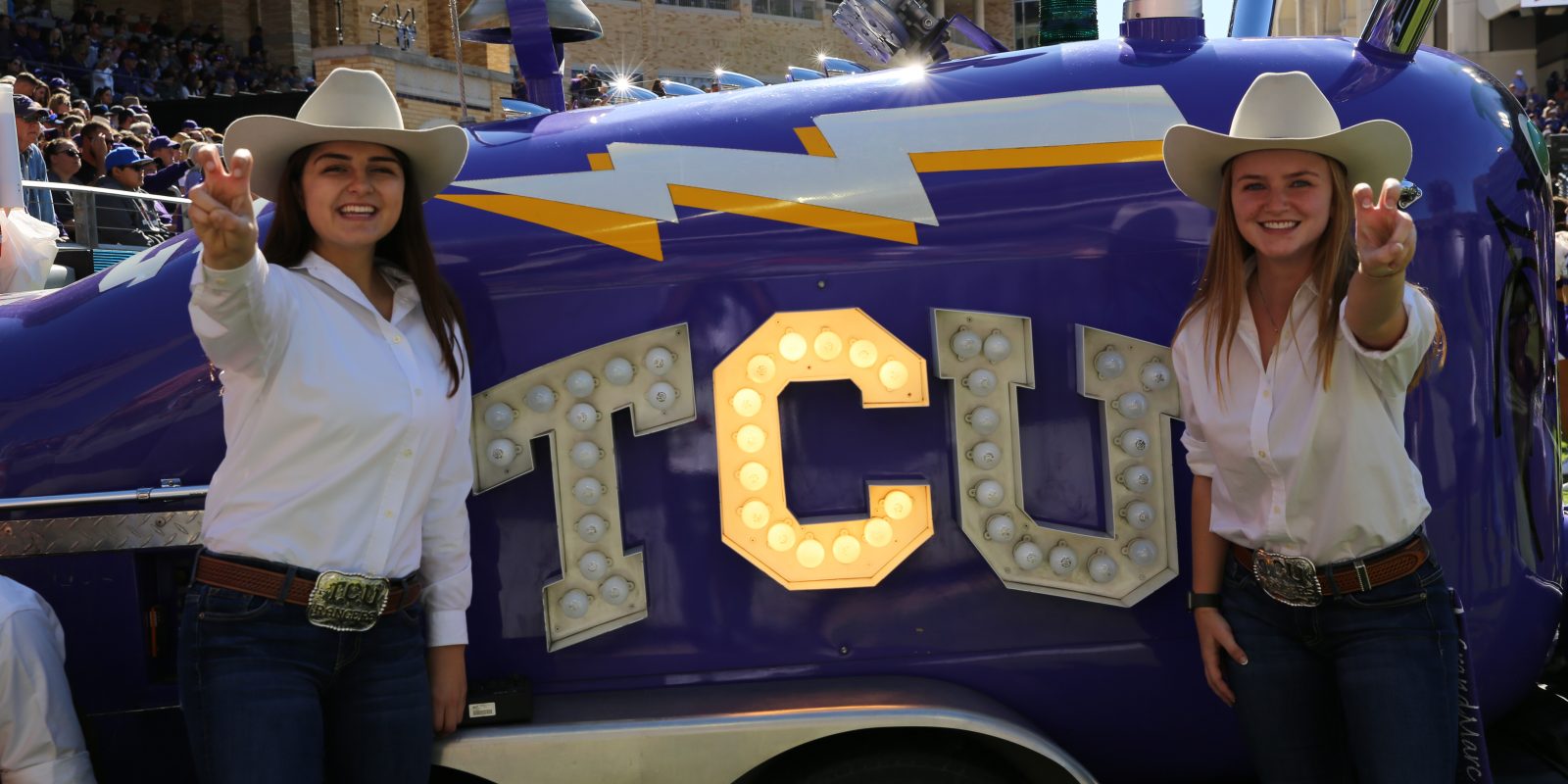
The shout of the Frog Horn is a staple at every home football game. Photo by Keja Johnson
Hhwaaaaaaaaaah! The Frog Horn!
What weights 3,000 pounds, blows smoke and instantly demands everyone’s attention? The huffing, puffing, hooting, tooting Frog Horn.
It’s 1958, and the No.9 Frogs are trouncing the No. 16 Longhorns at Amon G. Carter Stadium. In the south end zone, Kappa Sigma brothers George “Pookie” Powell ’59 and Theron Brooks ’59 have hoisted a home-made contraption onto the railing, and are waiting for the Frogs to score again.
When they do, the enterprising young men wrench open a valve and everything comes to a stand still as the stadium fills with the roar of a “borrowed” train whistle that the boys had cobbled onto the end of an air canister.
But turning it off isn’t so easy, and the thing blasts for 15 minutes before the air finally runs out. The game is stopped and officials ungraciously escort the boys from the stadium. The Frogs win, 22-8.
It’s 1994, and football Coach Pat Sullivan wonders aloud to alumnus Ted Lange ’59 (MBA ’59), why TCU doesn’t have any football traditions to get the crowds involved.
Lange, remembering the horn prank, calls his Kappa Sigma buddy Larry Lydick ’59 and the two enlist another pal from their TCU era, Bill Steele ’61 (MBA ’63), a local businessperson and TCU trustee, to help them recreate the 1958 sound — but this time do it right.
Steele calls fellow trustee and Burlington Northern Railroad CEO Gerald Grinstein and asks, “Could you guys make us a horn that would really blast at a football game?” Grinstein nods and says, “Let me handle it.”
Four hours later Steele and Lange are faxed preliminary drawings for a new contraption, this one a bit more thought out than the original.
The Horn is Born
A small group of men at Burlington’s Springfield, Mo., maintenance shop had less than four weeks to complete the horn, but the challenge energized them, says Dale Propp, who, as then-general superintendent of locomotive operations at Burlington, oversaw the project.
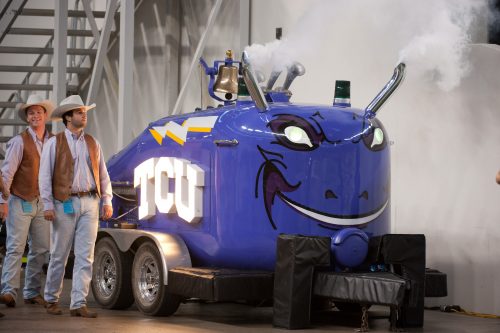
Marquee lights, green flashing eyes and horns spewing smoke are signature elements of Frog Horn. Photo by Glen E. Ellman
“They were very skilled craftsmen,” Propp says. “We had a lot of creative folks work on it, and they just fell in love with the project. Never at the railroad had they ever built something like that. I think they put about 14 coats of paint on it.”
During conversations between Propp, Steele and Lange, the “trailer with a horn” expanded to include marquee lights for TCU logos, green flashing eyes and purple theatrical smoke that poured from two chrome “horns” on top.
Those extras, of course, meant additional equipment under the cowling, so it overheated during a test drive. Vents were added to the body, which was all hand machined in the Springfield shop. A local artist was hired to paint the face after agreeing to give the beast a ferocious look.
After the “14” coats of paint dried, a bell from an old steam locomotive was added.
“The bell is all brass and worth probably $15,000,” Propp says. “They became very rare because they were being stolen, so years ago we took them all off, then gave them to old-timers when they retired.”
Propp rolled the cost of the horn into a locomotive rebuild project. When charges quickly passed the original estimate of $5,000, he stopped asking. If he knows, he’s not telling, but some say 10 times more, others say as much as $65,000.
The shiny new Frog Horn, weighing in at 3,000 pounds, was loaded onto a C-47 and flown to Fort Worth.
Steele was stunned by the finished product. “When they brought it down to one of my plants, I was just electrified,” he says. “This was something else — way beyond our expectations. Nobody else will ever have one of these. No other school.”
Dawning of a New Era
A few days before the Sept. 17, 1994, home opener against Kansas, Matt Johnson ’96, who was president of the Lariats (a student spirit group), hooked the horn to his Chevy half-ton truck and pulled it to the front of the Brown-Lupton Student Center. Lange remembers the surprised look Chancellor William E. Tucker ’56 had as he walked out of the building and eyed the mechanical monster.
“We hadn’t told anyone at TCU that we were making this,” Lange says. “So when Bill saw it for the first time, he was stunned, then delighted.”
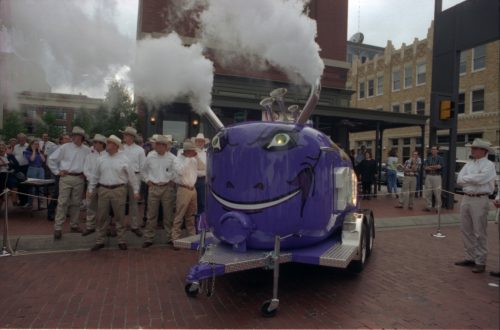
The Frog Horn — a gift from Burlington Northern Railroad — was unveiled at a downtown pep rally in 1994, then turned over to the Lariats, a now-defunct spirit group of fraternity leaders. Photo by Linda Kaye
The night before the game, the horn was formally unveiled during a “TCU Purple-Powered Pep Rally” in downtown Fort Worth. Burlington’s Grinstein was there to hand off the one-of-a-kind gift to the university.
The rally was the work of the Committee of 100, a group headed up by John Roach ’61 (MBA ’65), then-chair of the Board of Trustees. With a membership of several hundred community supporters, the committee’s goal was to increase attendance and make game day “a fun-filled event for the whole family.” That year Frog Alley, half-time entertainment, fireworks and the blasting of the Frog Horn became staples of the TCU game experience.
“It’s a new era in TCU athletics,” Roach proclaimed at the rally. How true that turned out to be — that season, the Frogs earned a spot in the Independence Bowl, their first bowl appearance in a decade. Before that? The Sun Bowl in 1965.
The next day, as the horn was rolled down to its game-day spot on the field, disaster nearly struck.
“They used a golf cart, but the horn outweighed the thing by about five times,” Lange recalls with a chuckle. “It ended up shoving that cart down in front of it and it nearly crashed into the goal post.” The staff wisely located a truck when it was time to return the Frog Horn to a spot beneath the west stands, where it was stored for many years.
Care and Feeding
Being the horn blower is a labor-intensive activity, requiring a high level of commitment. Not only does the machine require cleaning and hauling for games, parades and bowl appearances, maintenance is complicated.
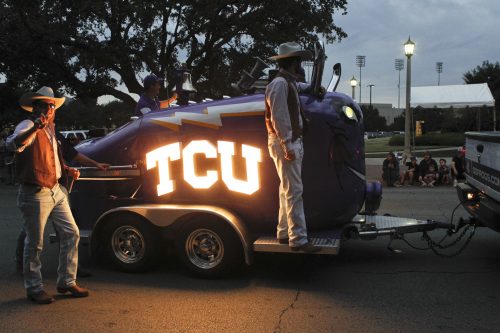
The Frog Horn starred in many homecoming parades. Photo by Sharon Ellman
For the first few years, Johnson and the now-defunct Lariats were in charge of the horn. While the horn is configured to run on gasoline or electricity, there wasn’t any plug on the field for a year or two.
“We had to run the engine to power it, and it was a hog. We were carrying 20 gallons of gas to the field in cans nearly every quarter,” Johnson recalls. “And if the wind wasn’t blowing, the exhaust would choke everybody.” Eventually power was run to the spot.
In subsequent years, Kenny “Frogman” Vaughn, an electrician in the physical plant, and Jeff Tucker ’00, who served as the cheerleading coach for several years, put in many volunteer hours as the horn’s keeper.
Since 2002, former roommates and band members Justin Garvin ’02 and Jason Lesikar ’02, along with Justin’s dad Jim Garvin, have lovingly cared for the horn, keeping it in running condition and managing it at games. It takes all three: One to watch the game and cue a second handler to ring the bell or blow the horn at the right time (a very important task since blasts at the wrong time can violate NCAA rules), and one to keep others at an appropriate distance.
“Even at a game, there are photographers and other people down on the field who want to blow it or ask us questions, so one of us has to manage that,” Justin Garvin says. “During other appearances, all three of us are there to answer questions and handle the crowds that gather around it.”
Lesikar keeps it in a secure facility on his ranch west of town and handles all the maintenance and repair — mostly out of his own pocket.
“I’m quite impressed with what Burlington Northern did,” Lesikar says. “I’ve torn it apart to repair and put it back together. At one point the horn wasn’t blasting like it should so I cleaned it up and got it working right again.”
It’s a fairly needy piece of machinery — it is 16 years old, after all, and parts are not only expensive, they are sometimes hard to locate. In recent years Lesikar crafted new fenders and replaced the fog machines and more light bulbs than he can count. Occasionally he has to crawl inside during a game to keep it blasting and flashing.
“It’s a big asset, but it’s also a big responsibility,” Lesikar says. “Getting to work on it has been a huge honor.”
One thing no one has fixed is a dent near the front that an opponent (reportedly a Texas Tech player) put there with his helmet in a moment of extreme frustration at the Frogs success on the field. “It’s part of its history,” Lesikar says, “so we’ve left it there.”
Thar She Blows
Today the link between the Frog Horn’s blast and a TCU score is so strong that EA Sports incorporated the sound into recent versions of their NCAA Football video game — when TCU scores, you hear the horn blow.
“I’m sure TCU fans of the game told the company, ‘Hey! Where’s our horn?’ ” says Jack Hesselbrock ’82 (MBA ’86), associate athletic director for internal relations. “So that’s where it’s gotten to. It’s so powerful.”
And incredibly visceral. It intimidates opponents and pumps up the Frogs so much that administrators do everything they can to get the horn to bowl games and other athletic events.
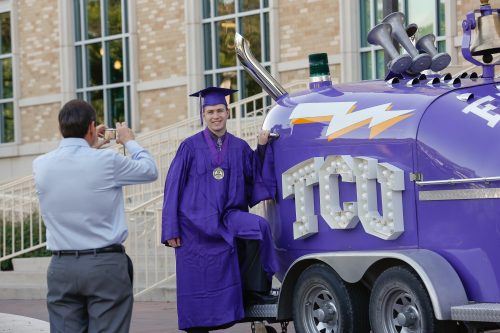
The Frog Horn is part of many special moments for students and alumni. Photo by Glen E. Ellman
There was a wave of disappointment when the horn wasn’t allowed on the field at last year’s Fiesta Bowl, but Hesselbrock says TCU pushed hard for it. In the end, small sidelines and the horn’s weight kept it off the raised field.
The horn made a huge splash at the Arizona game anyway, says Justin Garvin.
“About three years ago people began referring it an icon. In Phoenix I discovered it was a rock star. People were following exactly where it was at any moment,” he says. “They want to touch it, set their kids on it, get their picture with it. There were even hundreds of Boise State fans who came to pose for pictures with it.”
It didn’t hurt that the three horn blowers handed out purple koozies and mini footballs printed with Go Frogs!, which they purchased on their own.
For this year’s season opener against Oregon State, which was played at the Cowboy’s stadium in Arlington, Hesselbrock made sure the contract stipulated the horn would be on the field.
“They knew what it was and said, “Bring it on. We’ll find a place for it,” he says.
How appropriate: The world’s loudest college noisemaker at the world’s largest football stadium.
When Grinstein agreed in 1994 to build a horn that could help put TCU back on the college football map, the team wasn’t even in the Top 100. “The world has shifted and now you’re in the Top 10,” he notes, adding with a chuckle, “That’s because of the Frog Horn.”
Well, not just the horn. But it’s certainly helped the fans and the players get into the spirit of the game. Now anytime a train whistle sounds in Fort Worth, TCU fans smile a special kind of smile.The kind of smile that says, “Score!”
Share your stories:
Do you have a memory or story about the Frog Horn? Comment below or email it to tcumagazine@tcu.edu.

Your comments are welcome
4 Comments
I was an equipment manager for the football team back in ’94 and I remember the horn on the field. It’s been so long ago, I had forgotten that it wasn’t always around. The wow that it had those first few years was awesome to see. Thanks for the background story and GO FROGS!
Loved this post! The Frog Horn is such a unique piece of TCU culture. It’s great to see how traditions like this bring the community together. Can’t wait for the next game and to hear it in action! Go Frogs!
Related reading:
Mem’ries Sweet
It’s a boy. It’s a dog. It’s SuperFrog!
Over the course of a century, the TCU mascot has varied in design and species.